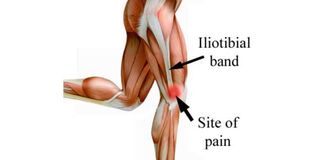Iliotibial band syndrome commonest cause of pain on outside of the knee

liotibial band.
What you need to know:
- In summary ITB pain is mainly an overuse syndrome often associated with an imbalance in training.
- When one is faced with ITB syndrome, a review of training protocols especially warm down and intensity of exercises normally will help resolve the problem in addition to having focussed physiotherapy.
This week we will look at iliotibial band syndrome, one of the commonest causes of pain on the outside of the knee particularly in runners and cyclists.
The iliotibial band (ITB) is a tough strip of tissue which extends from the hip to below the knee (see diagram). It is an important structure on to which a number of hip muscles are attached.
The muscles that connect to the ITB are important in moving the hip but also stabilising the knee. The ITB may also offer some protection to the outside of the knee.
In activities that require rapid and repetitive movements of the knee, friction may be created under the ITB as it runs over bone surfaces. This constant rubbing may lead to inflammation around the ITB causing knee pain. This pain is usually on the outside of the knee.
As mentioned earlier it is very commonly seen in runners and cyclists as these are typical activities in which the knee is constantly in motion. Most athletes complain of a ‘dull’ pain but some also describe a burning sensation or feeling something ’click’ or ‘snap’.
The pain may be present at the start of the activity after which it settles down or may come on during the activity. In some unfortunate athletes it may persist for the entire duration of the activity.
When clinical assessments are performed early, there is normally pain on the outside of the knee. However, when assessed later, there may be no pain demonstrated and so we rely on the athletes giving an accurate description of the pattern of pain.
On clinical assessment, the ITB is frequently found to be tight in individuals with this pain. When making the diagnosis it is important to ensure that the lateral meniscus (see earlier article) is normal as tears of the meniscus may masquerade as ITB syndrome.
When considering the risks for developing ITB syndrome it is important to look at warm up protocols and the amount of activity being performed.
One of the big risks of developing ITB pain is excessive exercise without enough rest between workouts. An additional risk factor in the developing ITB syndrome is poor or damaged footwear.
The initial treatment requires a period of rest to allow the inflamed tissue to settle down. This is followed by physiotherapy which involves a series of stretching exercises of the ITB and then a hip and knee strengthening program.
When considering the bigger picture, the training regime will need to be adjusted to include better warm up, managing intensity of activity and suitable recovery.
The warm down phase has also been shown to be important in preventing ITB pain and particularly the use of foam rollers which stretch the ITB.
Most athletes make a full recovery from ITB pain using the above measures. In a small percentage of athletes, the symptoms may persist for more than 6 months despite good physiotherapy and activity modification.
In this group there is a small role for surgery in releasing the ITB at the point of maximal friction. In carefully selected patients, surgery is successful in allowing the full return to sports.
In summary ITB pain is mainly an overuse syndrome often associated with an imbalance in training.
When one is faced with ITB syndrome, a review of training protocols especially warm down and intensity of exercises normally will help resolve the problem in addition to having focussed physiotherapy.





